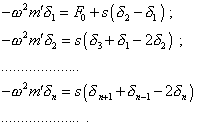V.2 No 1 |
19 |
| Homogeneous 1d resistant line | |
|
|
V.2 No 1 |
19 |
| Homogeneous 1d resistant line | |
|
|
After the conventional elimination of the time dependence |
| (4) |
where |
| (5) |
the system (3) takes the form |
 |
(6) |
We can easily see that (6) became fully identical to the conventional modelling system of differential equations for an ideal semi-infinite elastic line, for which in [10] the exact analytical time-dependent solutions have been obtained. They had the following form: for the periodical regime ( |
| (7) |
for the aperiodical regime ( |
| (8) |
and for the critical regime ( |
| (9) |
where |
| (10) |
| (11) |
| (12) |
Applying (7)–(9) to (6) as the solutions, we have to
take into account that after we substituted (5), parameter |
 |
(13) |
It means that in a resistant line only the periodical
regime (7) can exist. The critical and aperiodical regimes are possible only when
transiting to an ideal line, i.e. at a real value |
Contents: / 17 / 18 / 19 / 20 / 21 / 22 / 23 / 24 / 25 / 26 / 27 / 28 / 29 / 30 / 31 / 32 / 33 / 34 /